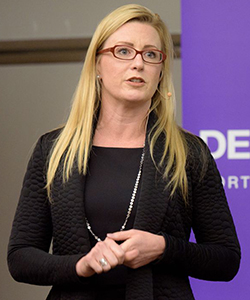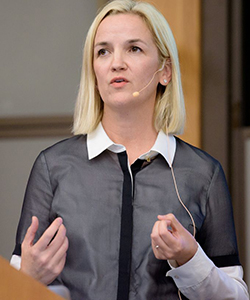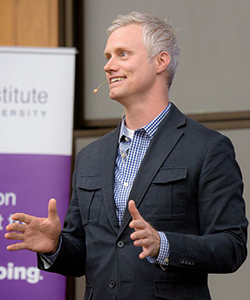Panelists Discuss Strategy at Design:Chicago
Industry leaders visited Northwestern for the ninth annual event on April 9
Watch the Design:Chicago 2015 presentations.
When Jeri Ward joined Audi of America in 2007, she was faced with a daunting problem. The luxury automobile company’s customer satisfaction ratings were tanking, and more than half of its customers were not returning to the brand. As the new director of customer experience, Ward was tasked with improving the numbers and exceeding consumer expectations.
 “We wanted to design moments both for the consumers and those who deliver them,” Ward said. “So we leveraged design in unexpected places.”
“We wanted to design moments both for the consumers and those who deliver them,” Ward said. “So we leveraged design in unexpected places.”
Ward shared her experiences with Audi on Thursday, April 9 at the ninth annual Design:Chicago seminar. Focusing on the theme of “Design as Strategy,” the event brought together the Northwestern community, public, and top designers and executives. Other panelists included Kathleen Brandenburg, founder and chief design strategy officer at IA Collaborative; Teaque Lenahan, executive director of innovation strategy at frog; and Larry Keeley, president and co-founder of Doblin Inc. and director at Deloitte Consulting.
To improve Audi customer experiences, Ward implemented human-centered design to inspire delight and strengthen the connection between the car and its driver. Her team joined and observed test drives and car deliveries to learn what mattered most to customers.
“We couldn’t just craft solutions in the conference room without knowing what works in the real world,” Ward said. “To really understand human behavior, you can’t just read a report. You have to experience it in the real world.”
Audi began tailoring test drives to individual customers and added more personalized details, such as presenting the new owner with keys in a luxury box. Since Ward joined the team, Audi’s rankings among other automobile brands have climbed a list from number 12 to 2 in customer satisfaction and from number 26 to 9 in sales satisfaction.
 Working with clients as diverse as Nike, Caterpillar, and Johnson & Johnson, Kathleen Brandenburg discussed the importance of using design to elevate and align a company with high-level purposes. She cited her company’s work with Godrej Group, an Indian conglomerate that launched in 1897. The company started when its founder, Ardeshir Godrej, designed a new ultra-secure lock. After being bit by the entrepreneurship bug, Godrej branched out to develop more and more products, including soap, food and beverages, typewriters, furniture, and construction materials.
Working with clients as diverse as Nike, Caterpillar, and Johnson & Johnson, Kathleen Brandenburg discussed the importance of using design to elevate and align a company with high-level purposes. She cited her company’s work with Godrej Group, an Indian conglomerate that launched in 1897. The company started when its founder, Ardeshir Godrej, designed a new ultra-secure lock. After being bit by the entrepreneurship bug, Godrej branched out to develop more and more products, including soap, food and beverages, typewriters, furniture, and construction materials.
“They create so many different types of products that we needed to build a design infrastructure to drive the company,” Brandenburg said.
Her team designed a set of six pillars for the company to organize its goals and deliberately create connections among its seemingly dissimilar niches. The pillars not only unified the brand but exposed opportunities for growth.
“Bringing a design mind to any company’s culture will be critical to its survival and success,” Brandenburg said. “Design-savvy competitors will dominate every market.”
Each generation has its own personality, so if a company wants to stay relevant, it needs to shift its strategies to embrace the mindset of the current generation. Teaque Lenahan refers to the current culture as the “Kickstarter Generation.” He said it’s less risk averse and more entrepreneurial than past generations, with a more creative and independent workforce that looks for more than just a paycheck.
“Everyone here is looking for more meaning in their jobs,” Lenahan said. “This can be challenging for those from a more traditional corporate culture, but they need to embrace the change and learn how to live with it.”
 Design firm frog has implemented four platforms to combine, grow, and share its team’s skills with partners and clients to extend the value of design. frogImpact works with social innovators to design solutions that address the needs of impoverished people. frogVentures uses venture design to help frog’s portfolio companies work smarter, iterate faster, and design better. Independent from its clients, frogLabs develops products that spring from the imaginations of its team. And frogCamp pairs its creative minds with partners and clients to teach user-centered design processes.
Design firm frog has implemented four platforms to combine, grow, and share its team’s skills with partners and clients to extend the value of design. frogImpact works with social innovators to design solutions that address the needs of impoverished people. frogVentures uses venture design to help frog’s portfolio companies work smarter, iterate faster, and design better. Independent from its clients, frogLabs develops products that spring from the imaginations of its team. And frogCamp pairs its creative minds with partners and clients to teach user-centered design processes.
“frog has so much talent, but some of it lies fallow,” Lenahan said. “These accelerators leverage our strengths to work on new things that clients aren’t asking about. They also motivate our worker and build the firm.”
A new product that emerged from frogLabs, for example, is the “Revolver” portable wind turbine. It collapses for easy storage and is able to harness clean energy at a moment’s notice. Lenahan imagines that it could be used to provide power in times of need, such as during unexpected outages. “Whether or not this will have a buyer, we don’t know,” he said. “But that’s not the point.”
Larry Keeley discussed the importance of democratizing design and taking innovation more seriously by viewing it as a science. He said that designers do not necessarily have to create something entirely new but can take old ideas and transform them into something different and compelling. He cited the transportation service Uber as an example. While taxis and mobile applications are nothing new, the idea to combine them has been enormously successful.
 “Innovation is less and less about primary invention and more about the elegant integration of things that are well known,” Keeley said. “Stitching things together, making it cool, making it memorable.”
“Innovation is less and less about primary invention and more about the elegant integration of things that are well known,” Keeley said. “Stitching things together, making it cool, making it memorable.”
Keeley also discussed the games like Candy Crush and World of Warcraft, which use “innovation with hyper sophistication.” At any given moment, Keeley said, six to eleven million people are playing World of Warcraft. Players design characters, self-organize into guilds, and work together to complete quests. He said this is an indicator of how people flock to smartly designed platforms that also allow the players to use creativity and design themselves. If the same design and gamification were applied to solving problems in health and poverty, people would be unstoppable, he said.
“We live in a special moment,” he said. “A time when innovation and design are giving up their secrets. A time of extraordinary change. We want to expect greatness. We should make the world better. Don’t you think we owe that to each other?”